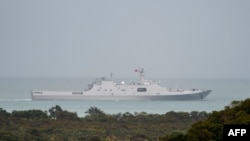China's navy will strengthen through 2050, analysts say, as the military power expands a key shipyard, steps up coordination and pursues a security deal with a South Pacific ally.
Chinese officials have signed a draft security agreement with South Pacific archipelago the Solomon Islands. That deal, announced last week, alarmed nearby Australia and New Zealand over the possibility of an eventual Chinese base in the Solomons for what is already the world's largest navy.
Recently, Naval News, an official newspaper of the British Royal Navy, published an article describing a "massive expansion" of China's biggest shipbuilding site. That site, the Jiangnan Shipyard in Shanghai, is expected to have a basin for fitting out ships and a "large" drydock with multiple berths, the newspaper reported.
China has been expanding another two facilities to build nuclear submarines, the report added. It said the expansion opens the possibly of building nuclear-powered aircraft carriers for the People's Liberation Army Navy.
A spokesperson for the Chinese Embassy in Washington did not answer a request for comment this week about military modernization.
Parts of longer voyage
The initiatives position the Chinese navy to improve through 2050, said Collin Koh, a maritime security research fellow at Nanyang Technological University in Singapore.
"Clearly the Chinese are already in the process of bulking up, so I think it might actually be sooner than we actually imagine," Koh said.
Chinese President Xi Jinping told a Communist Party congress in 2017 that he aimed to "basically complete" military modernization by 2035 and transform the armed forces into a "world-class" military by 2049, according to a U.S. Department of Defense paper released last year.
Jiangnan is a key site for making aircraft carriers, cruisers, destroyers and submarines. The navy had 512 ships in 2012, according to Britain's International Institute for Strategic Studies, a research group. It now has more than 700, the database Globalfirepower.com says.
China's most formidable rival would be the United States. The former Cold War rival has sent warships to the South China Sea and Taiwan Strait in respone to Beijing's perceived aggression toward smaller Asian governments. On Monday, U.S. Marine Corps Commandant Gen. David Berger said his troops should do more "campaigning forward" to deter China at sea.
Dearth of ports
A port in the Solomons would ease a shortage of places to moor ships as the Chinese navy tries to project influence into the Pacific Ocean, experts believe. China's foreign naval bases today are in Myanmar, Pakistan and Djibouti.
"The CCP (Communist Party of China) not only wants to control the first island chain, but also use that as a base and expand their influence to reach the second island chain," said Chieh Chung, an associate researcher at the National Policy Foundation in Taiwan, in a phone interview with VOA Mandarin.
The first chain refers to the band of islands stretching from the Kuril Islands north of Japan to Borneo. The second includes Papua New Guinea, the Marianas and the Caroline Islands.
Analysts believe any Solomons base is a way off. Protesters rioted in the South Pacific country in November partly because of their country's links with China. The Solomons established diplomatic ties with Beijing in 2019, casting off former ally Taiwan.
Solomon Islanders resented Australia as a "big brother" in the past and wonder whether China is the next one, said Alexander Vuving, professor at the Daniel K. Inouye Asia-Pacific Center for Security Studies in Hawaii.
Command structure overhaul
China faces the longer-term challenge of decentralizing its military command to put battlefield decisions in the hands of field commanders and make fighting more efficient, some experts believe. It's more "top-down" today than the U.S. military despite efforts since 2016 to improve coordination, said Derek Grossman, senior defense analyst with the U.S.-based RAND Corporation, a research organization.
The People's Liberation Army network launched an overhaul in 2017 aimed at improving coordination, according to a National Defense University Center for the Study of Chinese Military Affairs paper.
A key would be aligning the army, strategic support forces and rocket forces in the event of any war, Grossman said. "It's not just numbers," he said, referring to equipment and troops. "I think it's also obviously the quality of their capability, if they're able to use all of these assets in a coordinated fashion."
China has not entered combat since the 1970s, when it lost a border war to Vietnam.
The crew aboard China's two aircraft carriers need more time to train, said Andrew Yang, secretary-general of the Chinese Council of Advanced Policy Studies research group in Taiwan. The United States has 11 aircraft carriers.
"I think those two aircraft carriers are not ready for real combat yet, because they need a time to train their crews in how to coordinate other combatants in their mission and also in a way to train the carrier fighter jets," Yang said.
China's growing number of ships "may just come to naught" without more training and improved "command and control," Koh said.
VOA's Lin Yang and Jin Gu contributed to this report.















